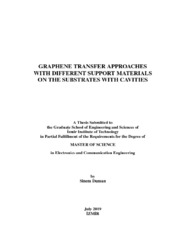Please use this identifier to cite or link to this item:
https://hdl.handle.net/11147/7485Full metadata record
| DC Field | Value | Language |
|---|---|---|
| dc.contributor.advisor | Balantekin, Müjdat | - |
| dc.contributor.advisor | Çelebi, Cem | - |
| dc.contributor.author | Duman, Sinem | - |
| dc.date.accessioned | 2019-12-16T11:24:07Z | |
| dc.date.available | 2019-12-16T11:24:07Z | |
| dc.date.issued | 2019-07 | - |
| dc.identifier.citation | Duman, S. (2019). Graphene transfer approaches with different support materials on the substrates with cavities. Unpublished master's thesis, İzmir Institute of Technology, İzmir, Turkey | en_US |
| dc.identifier.uri | https://hdl.handle.net/11147/7485 | - |
| dc.description | Thesis (Master)--Izmir Institute of Technology, Electronics and Communication Engineering, Izmir, 2019 | en_US |
| dc.description | Includes bibliographical references (leaves: 51-59) | en_US |
| dc.description | Text in English; Abstract: Turkish and English | en_US |
| dc.description.abstract | A micro capacitive sensor characteristically embraces a thin conductive membrane which is freely suspended above an immovable counter electrode in a parallel plate geometry. Such capacitive structures are found in broad range of applications as a transducer like capacitive micro-machined ultrasonic transducer (CMUT), pressure sensor, resonator and biological or chemical material sensing element. The input can be an ultrasound wave, pressure, chemical or biological mass attachment which result in the deflection of the membrane. Emerging nano materials have shown great potential as candidates for generation of nano and micro electromechanical systems (NEMS, MEMS). Among these nano materials, graphene is regarded as a promising material because of its ultra low mass, thickness, high surface to volume ratio, flexibility, and extraordinary electrical and mechanical properties. However, the transfer of graphene on substrates with micro scale cavities is challenging since the fabrication of large area membranes with a smaller air gap often results in membrane tearing or collapse driven by capillary or electrostatic forces. This study presents a research on the fabrication and the characterization of graphene membranes to be used in micro capacitive sensor applications. Substrates which span a large array of circular and hexagonal micro cavities between 2-100 μm in diameter are fabricated. Graphene transfer with different support materials are studied to fabricate graphene micro membranes. Up to 5 μm diameter membranes on 300 nm deep cavities are demonstrated via scanning electron microscope (SEM) and atomic force microscope (AFM) tools. | en_US |
| dc.description.abstract | Mikro kapasitif sensör, karakteristik olarak, iletken ve hareketsiz duran bir alt elektrot ile buna paralel olarak yerleştirilmiş iletken ve hareket edebilen bir üst elektrottan oluşur. Bu yapı, kapasitif mikro-işlenmiş ultrasonik çevirgeç, basınç sensörü, resonatör ve biyolojik yada kimyasal madde algılama elemanı gibi uygulamalarda dönüştürücü olarak bulunabilir. Membran yapısında eğilmeye yol açan fiziksel girdi ultrason dalgası, basınç, biyolojik yada kimyasal bir malzeme olabilir. Nano malzemeler, yeni nesil nano ve mikro elektro mekanik sistemlerin (NEMS, MEMS) geliştirilmesinde büyük potansiyele sahiptir. Nano malzemelerin arasında grafen çok küçük kütlesi, yüksek yüzey hacim oranı, esnekliği, özel elektriksel ve mekanik özelliklerinden dolayı öne çıkan bir malzemedir. Ancak, grafenin kapasitif yapılar oluşturmak üzere mikro ölçekte oyuklu örnekler üzerine aktarılması kılcal veya elektrostatik kuvvetlerin etkisinden ötürü membran yapısının çökmesi veya yırtılması ile sonuçlanabilir. Bu çalışma, kapasitif mikro sensör olarak kullanılmak üzere çok ince grafen membranlarının oluşturulmasını ve karakterizasyonunu içermektedir. Bu amaç ile çapları 2 ile 100 μm arasında değişen deşikli alttaşlar hazırlanmıştır. Grafen mikro membran üretimi için, farklı destek malzemeleri kullanılarak, grafen transferi gerçekleştirilmiştir. 300 nm derinliğinde deşikli yapılar üzerinde çapları 5 μm'ye kadar ulaşan grafen membranlar taramalı elektron ve atomik kuvvet mikroskobu ölçümleri ile gösterilmiştir. | en_US |
| dc.description.sponsorship | TUBITAK (117F186) | en_US |
| dc.format.extent | xii, 56 leaves | - |
| dc.language.iso | en | en_US |
| dc.publisher | Izmir Institute of Technology | en_US |
| dc.rights | info:eu-repo/semantics/openAccess | en_US |
| dc.subject | Graphene | en_US |
| dc.subject | Electromechanical systems | en_US |
| dc.subject | Micro cavities | en_US |
| dc.title | Graphene Transfer Approaches With Different Support Materials on the Substrates With Cavities | en_US |
| dc.title.alternative | Oyuklu Alt Taşlar Üzerinde Farklı Destek Malzemeleri ile Grafen Aktarma Yaklaşımları | en_US |
| dc.type | Master Thesis | en_US |
| dc.institutionauthor | Duman, Sinem | - |
| dc.department | Thesis (Master)--İzmir Institute of Technology, Electrical and Electronics Engineering | en_US |
| dc.relation.tubitak | info:eu-repo/grantAgreement/TUBITAK/MFAG/117F186 | - |
| dc.relation.publicationcategory | Tez | en_US |
| dc.identifier.wosquality | N/A | - |
| dc.identifier.scopusquality | N/A | - |
| item.openairecristype | http://purl.org/coar/resource_type/c_18cf | - |
| item.languageiso639-1 | en | - |
| item.openairetype | Master Thesis | - |
| item.grantfulltext | open | - |
| item.fulltext | With Fulltext | - |
| item.cerifentitytype | Publications | - |
| crisitem.author.dept | 03.05. Department of Electrical and Electronics Engineering | - |
| Appears in Collections: | Master Degree / Yüksek Lisans Tezleri | |
Files in This Item:
| File | Description | Size | Format | |
|---|---|---|---|---|
| T002040.pdf | MasterThesis | 3.91 MB | Adobe PDF |  View/Open |
CORE Recommender
Page view(s)
398
checked on Mar 31, 2025
Download(s)
432
checked on Mar 31, 2025
Google ScholarTM
Check
Items in GCRIS Repository are protected by copyright, with all rights reserved, unless otherwise indicated.